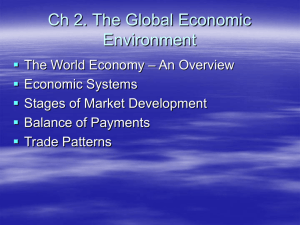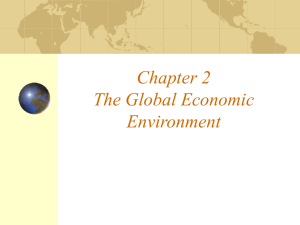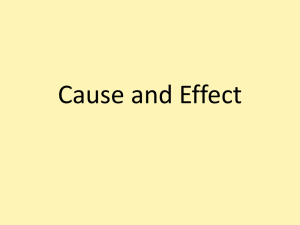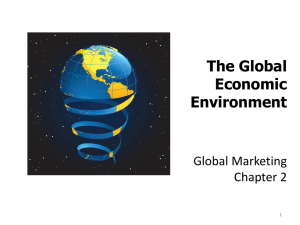keegan02 The Global Economic Environment
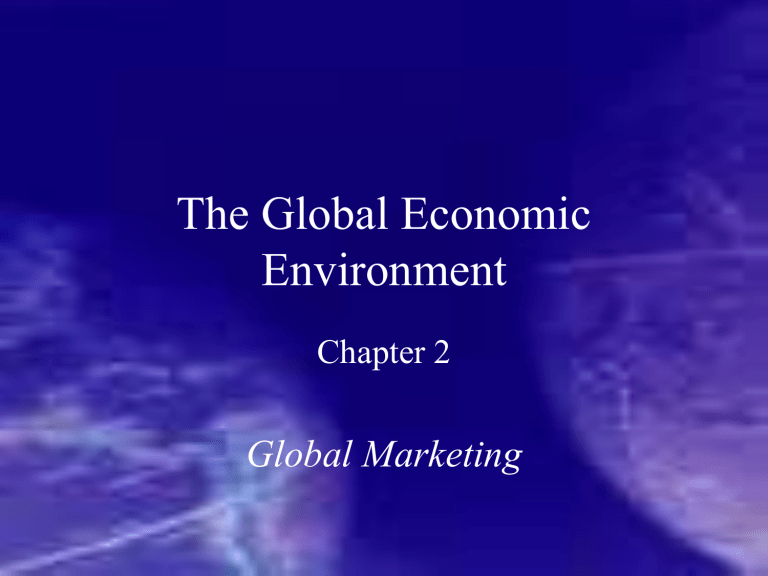
The Global Economic
Environment
Chapter 2
Global Marketing
Changes in the World Economy
• Emergence of global markets
• Integration of world economy
• Increased volume of capital movements
• End of the Cold War
• Diminishing importance of national boundaries due to technological advancements
Keegan and
Green, Chapter 2
2
Economic Systems
• Market capitalism
• Centrally planned socialism
• Centrally planned capitalism
• Market socialism
Keegan and
Green, Chapter 2
3
Private
Resource
Ownership
Economic Systems
Resource Allocation
Market Command
Market
Capitalism
Centrally
Planned
Capitalism
State
Market
Socialism
Centrally
Planned
Socialism
Keegan and
Green, Chapter 2
4
Market Capitalism
• Economic system in which individuals and firms allocate resources:
– Production resources are privately owned
– Consumers decide what goods are desired and firms determine what and how much to produce
– Role of state is to promote competition and protect consumers
Keegan and
Green, Chapter 2
5
Centrally Planned Socialism
• Opposite of market capitalism
• State holds broad powers to serve the public interest; decides what goods and services are produced and in what quantities
• Consumers can spend on what is available
• Government owns entire industries
• Demand typically exceeds supply
• Little reliance on product differentiation, advertising, pricing strategy
Keegan and
Green, Chapter 2
6
Centrally Planned Capitalism
• Economic system in which command resource allocation is used extensively in an environment of private resource ownership
• Examples:
– Sweden
– Japan
Keegan and
Green, Chapter 2
7
Market Socialism
• Economic system in which market allocation policies are permitted within an overall environment of state ownership
• Examples:
– China
– India
Keegan and
Green, Chapter 2
8
Degrees of Economic Freedom
• Free
– Hong Kong
– Singapore
– Ireland
– New Zealand
– United States
– United Kingdom
– Netherlands
– Australia
– Switzerland
Keegan and
Green, Chapter 2
• Repressed
– Bosnia
– Vietnam
– Laos
– Iran
– Cuba
– Iraq
– Libya
– North Korea
– Congo
9
BEMs: Big Emerging Markets
• China
• India
• Indonesia
• South Korea
• Brazil
• Mexico
• Argentina
• South Africa
• Poland
• Turkey
Keegan and
Green, Chapter 2
10
Low Income Countries
• GNP per capita of $785 or less
• Characteristics
– Limited industrialization
– High percentage of population involved in farming
– High birth rates
– Low literacy rates
– Heavy reliance on foreign aid
– Political instability and unrest
• Of these, only China and India are BEMs
Keegan and
Green, Chapter 2
11
Lower Middle Income Countries
• GNP per capita between $786 and $3,125
• Sometimes called less-developed countries
(LDCs)
• Characteristics
– Early stages of industrialization
– Cheap labor markets
– Factories supply items such as clothing, tires, building materials, and packaged foods
• 3 BEMs: Poland, Turkey, Indonesia
Keegan and
Green, Chapter 2
12
Upper Middle Income Countries
• GNP per capita between $3,126 to $9,655
• Characteristics
– Rapidly industrializing
– Rising wages
– High rates of literacy and advanced education
– Lower wage costs than advanced countries
• Sometimes called newly industrializing economies
(NIEs)
• 3 BEMs: Argentina, Brazil, Mexico, South Africa
Keegan and
Green, Chapter 2
13
High Income Countries
• GNP per capita above $9,656
• Sometimes referred to as post-industrial countries
• Characteristics
– Importance of service sector, information processing and exchange, and intellectual technology
– Knowledge as key strategic resource
– Orientation toward the future
Keegan and
Green, Chapter 2
14
G-7 Countries
• Leaders from these high income countries work to establish prosperity and ensure monetary stability
– United States
– Japan
– Germany
– France
– Britain
– Canada
– Italy
Keegan and
Green, Chapter 2
15
The Triad
• Dominant economic centers of the world
– Japan
– Western Europe
– United States
• Expanded Triad
– Pacific Region
– North America
– European Union
Keegan and
Green, Chapter 2
16
Leading Exporters and Importers
• Exporters
– United States
– Germany
– Japan
– China
– France
– United Kingdom
– Canada
– Italy
Keegan and
Green, Chapter 2
• Importers
– United States
– Germany
– United Kingdom
– France
– Japan
– Netherlands
– Canada
– Italy
17
